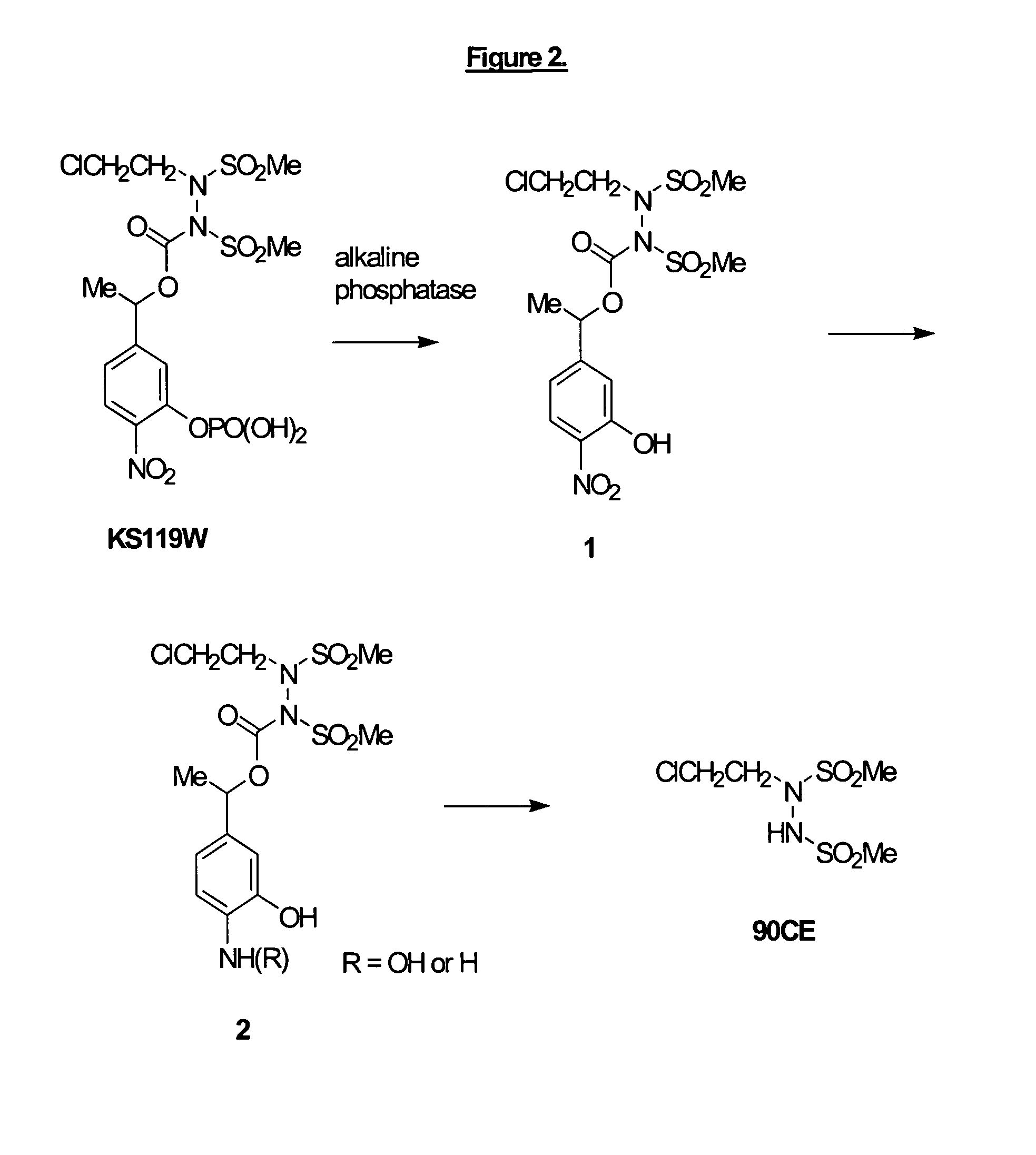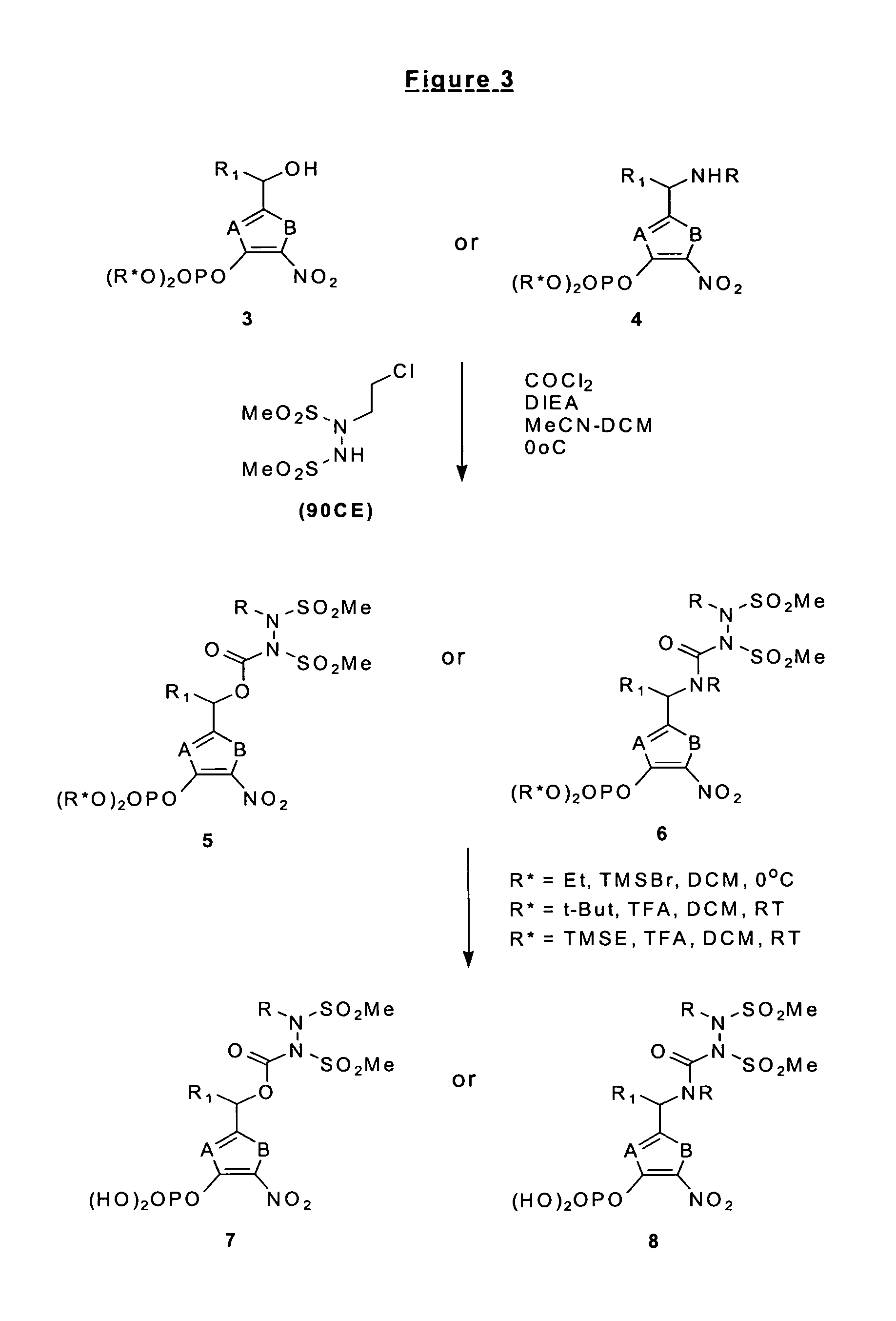Phosphate-bearing prodrugs of sulfonyl hydrazines as hypoxia-selective antineoplastic agents
a sulfonyl hydrazine and prodrug technology, applied in the field of sulfonyl hydrazine prodrugs, can solve the problems of poor oxygenation, high interstitial pressure, low oxygen, etc., and achieve the effects of reducing toxicity, enhancing anti-neoplasia activity, and effective compounds
- Summary
- Abstract
- Description
- Claims
- Application Information
AI Technical Summary
Benefits of technology
Problems solved by technology
Method used
Image
Examples
examples
[0098]All reagents were purchased at commercial quality and used without further purification, and solvents were dried and / or distilled prior to use where necessary. All NMR spectra (1H, 13C and 31P) were determined on a Bruker AC300 spectrometer. Chemical shifts are measured in parts per million (ppm) relative to tetramethylsilane. Coupling constants are reported in Hertz (Hz). Flash column chromatography (FCC) was performed with Merck silica gel 60 (230-400 mesh), and reserved phase column chromatography (RPCC) was packed with CAT gel (Water, preparative C-18, 125 Å, 55-105 μm) eluting with milli-Q de-ionized water.
examples 1-2
Phosphorylation of Phenolic Compounds
[0099]General Procedure A. To a stirred solution of the appropriately phenolic compound (10.0 mmol) in acetonitrile (15 mL) was added DMAP (1 mmol) and DIPEA (20 mmol) at room temperature. The reaction mixture was cooled to −13° C. A solution of dialkyl chlorophosphate (10 mmol) in acetonitrile (5 mL) was added dropwise to maintain internal temperature at less than −10° C. The reaction mixture was raised to 0° C. and then kept stirring for 2 hours, monitoring reaction completion by TLC. The reaction mixture was concentrated by rotary evaporation, and the oil residue was worked up with dichloromethane and 0.5 M aqueous KHSO4 solution. The organic layer was dried over anhydrous MgSO4, then filtered and concentrated to brown viscous oil. The crude dialkylphosphonoxy-aryl compound could be used without further purification.
[0100]1-(3-Diethylphosphonoxy-4-notrophenyl)ethyl alcohol (13). Following the general procedure A, R-1-(3-hydroxy-4-nitrophaenyl)...
example 3
Reduction of Acetophenones
[0110]General Procedure. To a solution of the A solution of chiral (R or S)-2-methyl-CBS-oxazaborolidine (1.0 M solution in toluene, 240 mL) and 1.0 M BH3-THF solution (120 mL) was cooled to −50° C. To the above solution was slowly added a solution of 3′-hydroxy-4′-nitroacetophenone (100 g) in THF / toluene (200 mL / 800 mL) and 1.0 M BH3-THF solution (1.0 L) simultaneously over 4 hours, while stirring vigorously. The reaction mixture was kept stirring at −50° C. for 2-3 hours, monitoring reaction completion by HPLC. Then, acetone (200 mL) was dropwise charged into the reactor at −50° C. After stirred at −50° C. for 10 minutes, the reaction mixture was allowed to warm up to ambient temperature and stir for 1.5 hours. Concentrated by rotary evaporation on 45° C. bath, the residue was treated with saturated Na2CO3 aqueous solution (2 L). The mixture was heated at 50° C. for 30 min, and then cooled down to room temperature. Added tert-butylmethylether (TBME, 1 L) ...
PUM
| Property | Measurement | Unit |
|---|---|---|
| solubility | aaaaa | aaaaa |
| pH | aaaaa | aaaaa |
| concentrations | aaaaa | aaaaa |
Abstract
Description
Claims
Application Information
 Login to View More
Login to View More - R&D
- Intellectual Property
- Life Sciences
- Materials
- Tech Scout
- Unparalleled Data Quality
- Higher Quality Content
- 60% Fewer Hallucinations
Browse by: Latest US Patents, China's latest patents, Technical Efficacy Thesaurus, Application Domain, Technology Topic, Popular Technical Reports.
© 2025 PatSnap. All rights reserved.Legal|Privacy policy|Modern Slavery Act Transparency Statement|Sitemap|About US| Contact US: help@patsnap.com



